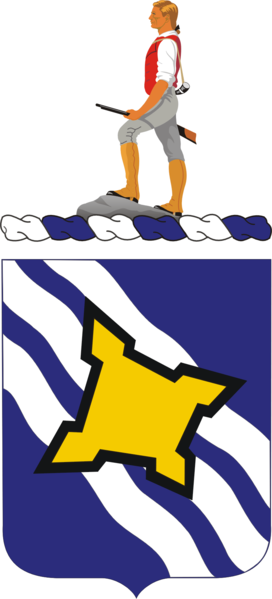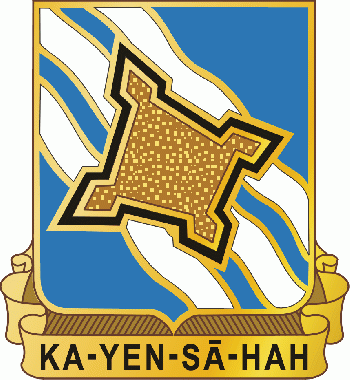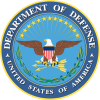390th (Infantry) Regiment, US Army: Difference between revisions
(Created page with "{{usa}} ''' {{uc:{{PAGENAME}}}} ''' [[File:{{PAGENAME}}.png|center|350 px|Coat of arms (crest) of the {{PAGENAME}}]] ===Official blazon=== ===Origin/meaning=== {{missing...") |
Knorrepoes (talk | contribs) m (Text replacement - ": " to ":") |
||
| (15 intermediate revisions by 2 users not shown) | |||
| Line 1: | Line 1: | ||
{{ | ''' {{uc:{{PAGENAME}}}} ''' | ||
{|align="center" | |||
|align="center"|[[File:{{PAGENAME}}.png|center|350 px|Coat of arms (crest) of {{PAGENAME}}]] <br> (Coat of Arms) | |||
|align="center"|[[File:{{PAGENAME}}dui.gif|center|350 px|Coat of arms (crest) of {{PAGENAME}}]]<br> (Distinctive Unit Insignia) | |||
|} | |||
===Official blazon=== | ===Official blazon=== | ||
Shield:Azure, three bendlets wavy Argent, overall a four bastioned fort of the outline of old Fort Stanwix Or fimbriated Sable.<br> | |||
Crest:That for the regiments and separate battalions of the Army Reserve:From a wreath Argent and Azure, the Lexington Minute Man Proper. The statue of the Minute Man, Captain John Parker (H.H. Kitson, sculptor), stands on the common in Lexington, Massachusetts.<br> | |||
Motto:KA-YEN-SĀ-HAH (Keep The Flag Flying). | |||
Distinctive Unit Insignia. Description:A Gold color metal and enamel device 1 5/16 inches (3.33 cm) in height overall consisting of a shield blazoned:Azure, three bendlets wavy Argent, overall a four bastioned fort of the outline of old Fort Stanwix Or fimbriated Sable. Attached below the shield a Gold scroll inscribed "KA-YEN-SĀ-HAH" in Black letters. | |||
===Origin/meaning=== | ===Origin/meaning=== | ||
{{ | The 390th Infantry was organized after World War I and allocated to Central New York. The coat of arms is devised on the military traditions of the home territory. The most important military event in the history of the area was the defense of Fort Stanwix, built in 1758, on the site of the present city of Rome, New York. In August 1777, the fort was under the command of Colonel Peter Gansevoort. Word was brought of the newly adopted stars and stripes flag - one was made in the fort and displayed on 3 August 1777, and flew defiantly throughout the siege of St. Leger. This was the first time the Stars and Stripes flag came under fire and the fort is known as the fort which "Never surrendered." The regimental area is crossed by three main rivers - the Susquehanna, Black and Mohawk, all of historic significance. This fort was of distinctive design (bastion) and records of the original survey are available. The shield is the Infantry blue crossed by the three white rivers and over all the old fort in gold and black. The motto "Ka-yen-sā-hah" is an Iroquois Indian word meaning "flag up," or more freely translated "keep the flag flying." The close and free translations are appropriate as applying to the first place the flag went up and as the place where it did not come down. | ||
The arms were originally approved for the 390th Regiment Infantry, Organized Reserves on 23 August 1924. It was redesignated for the 390th Regiment, Army Reserve on 26 January 1962. The Distinctive Unit Insignia was originally approved for the 290th Regiment Infantry, Organized Reserves on 3 June 1924. It was redesignated for the 390th Regiment, Army Reserve on 26 January 1962. The insignia was amended to add a motto on 11 December 1969. | |||
[[Literature]]:Images from Wikimedia Commons. Information from The Institute of Heraldry, US Army. | |||
{{us}} | |||
{{media}} | {{media}} | ||
[[Category:Military heraldry of the United States]] | [[Category:Military heraldry of the United States]] | ||
[[Category:Army heraldry]] | [[Category:Army heraldry]] | ||
[[Category:Granted 1924]] | |||
Latest revision as of 12:40, 6 August 2024
390TH (INFANTRY) REGIMENT, US ARMY
| (Coat of Arms) |
(Distinctive Unit Insignia) |
Official blazon
Shield:Azure, three bendlets wavy Argent, overall a four bastioned fort of the outline of old Fort Stanwix Or fimbriated Sable.
Crest:That for the regiments and separate battalions of the Army Reserve:From a wreath Argent and Azure, the Lexington Minute Man Proper. The statue of the Minute Man, Captain John Parker (H.H. Kitson, sculptor), stands on the common in Lexington, Massachusetts.
Motto:KA-YEN-SĀ-HAH (Keep The Flag Flying).
Distinctive Unit Insignia. Description:A Gold color metal and enamel device 1 5/16 inches (3.33 cm) in height overall consisting of a shield blazoned:Azure, three bendlets wavy Argent, overall a four bastioned fort of the outline of old Fort Stanwix Or fimbriated Sable. Attached below the shield a Gold scroll inscribed "KA-YEN-SĀ-HAH" in Black letters.
Origin/meaning
The 390th Infantry was organized after World War I and allocated to Central New York. The coat of arms is devised on the military traditions of the home territory. The most important military event in the history of the area was the defense of Fort Stanwix, built in 1758, on the site of the present city of Rome, New York. In August 1777, the fort was under the command of Colonel Peter Gansevoort. Word was brought of the newly adopted stars and stripes flag - one was made in the fort and displayed on 3 August 1777, and flew defiantly throughout the siege of St. Leger. This was the first time the Stars and Stripes flag came under fire and the fort is known as the fort which "Never surrendered." The regimental area is crossed by three main rivers - the Susquehanna, Black and Mohawk, all of historic significance. This fort was of distinctive design (bastion) and records of the original survey are available. The shield is the Infantry blue crossed by the three white rivers and over all the old fort in gold and black. The motto "Ka-yen-sā-hah" is an Iroquois Indian word meaning "flag up," or more freely translated "keep the flag flying." The close and free translations are appropriate as applying to the first place the flag went up and as the place where it did not come down.
The arms were originally approved for the 390th Regiment Infantry, Organized Reserves on 23 August 1924. It was redesignated for the 390th Regiment, Army Reserve on 26 January 1962. The Distinctive Unit Insignia was originally approved for the 290th Regiment Infantry, Organized Reserves on 3 June 1924. It was redesignated for the 390th Regiment, Army Reserve on 26 January 1962. The insignia was amended to add a motto on 11 December 1969.
Literature:Images from Wikimedia Commons. Information from The Institute of Heraldry, US Army.
US heraldry portal
This page is part of the US heraldry portal |
Heraldry of the World |
|
US heraldry:
|
Ecclesiastical Heraldry of the USA:
Military Heraldry: |
Contact and Support
Partners:
Your logo here ?
Contact us
© since 1995, Heraldry of the World, Ralf Hartemink 
Index of the site
















